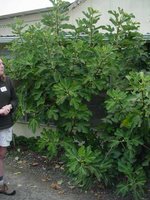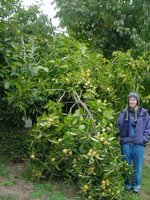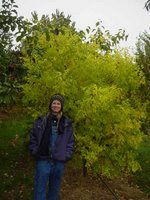Continuing the theme of "type up scattered notes before they get lost forever", here's what I jotted down on the two tours we've taken of One Green World's orchard. The tour spiels and plants visited were pretty much the same fall and this fall, so I'll basically combine the two tours into one set of notes, plus include the pictures we took.

 Figs crop twice, once in the summer and again in the fall. Some varieties have their main, heaviest crop in the summer, and others in the fall. In this region, Desert King is a good variety for a heavy 1st crop. Latarulla is a good variety for a heavy 2nd crop. Figs are somewhat deer resistant, due to their latex. The fig on the left is Latarulla, on the right is Peter's Honey, 3-4 years after planting as a 1-2 year old cutting propagation. Of the figs OGW sells, Peter's Honey is the sweetest, but has the longest ripening time so needs a good warm spot outside of Portland in this region. (In Portland we're a warmer microclimate in general already.)
Figs crop twice, once in the summer and again in the fall. Some varieties have their main, heaviest crop in the summer, and others in the fall. In this region, Desert King is a good variety for a heavy 1st crop. Latarulla is a good variety for a heavy 2nd crop. Figs are somewhat deer resistant, due to their latex. The fig on the left is Latarulla, on the right is Peter's Honey, 3-4 years after planting as a 1-2 year old cutting propagation. Of the figs OGW sells, Peter's Honey is the sweetest, but has the longest ripening time so needs a good warm spot outside of Portland in this region. (In Portland we're a warmer microclimate in general already.)



Akebias sold by OGW come in two species, the 3-leafed and the 5-leafed. Both produce seedpods which contain a white pulp around hard, inedible seeds. We were able to eat some pulp; the texture and taste are reminiscent of tapioca pudding. The pods are also edible; in Japan they're cooked as a vegetable. They can be stuffed and eaten like a pepper. It doesn't seem like a huge food crop, but if you want an ornamental vine it definitely has bonus food value. The 3-leaf pod is thicker and harder than the 5-leaf pod. Akebias are semi-evergreen, meaning they'll stay evergreen in a mild climate, but start losing some or all of their leaves if it gets too cold (I believe the temperature given was consistently in the low 20s? Or high teens?) They're low maintenance; at OGW they just whack the vines back as needed and the vines bloom just fine. The akebia picture on the left is the 3-leafed "Deep Purple", and the picture on the right is a 5-leafed variety.
 Flowering quince has citrus-like fruit on shrubs. I keep wondering whether the fruit has the same acidic properties and whether it can be used straight-up in recipes.
Flowering quince has citrus-like fruit on shrubs. I keep wondering whether the fruit has the same acidic properties and whether it can be used straight-up in recipes.
Aronia is good for adding to apple juice. On their own the juice is only "ok".
Beautyberry has unique purple berries which hang on the branches after the leaves drop. They berries are very bitter, but edible.
Empress tree is a fast grower! Considered a weed tree by many people.


 Persimmons - astringent types can be fast-ripened overnight in hot water at the right temperature. Astringent varieties are always sweeter than non-astringent. The persimmon on the left is an American persimmon, which are all large trees with relatively small, astringent fruit. On the right are two different Asian persimmons, one so loaded with fruit its branches are badly in need of extra support! The Saijo persimmon is ideal for drying (and from other conversations I've had with OGW, seems to be the only proven astringent variety for this area.) Fuyu is a dry crisp [did I get that right?] non-astringent variety.
Persimmons - astringent types can be fast-ripened overnight in hot water at the right temperature. Astringent varieties are always sweeter than non-astringent. The persimmon on the left is an American persimmon, which are all large trees with relatively small, astringent fruit. On the right are two different Asian persimmons, one so loaded with fruit its branches are badly in need of extra support! The Saijo persimmon is ideal for drying (and from other conversations I've had with OGW, seems to be the only proven astringent variety for this area.) Fuyu is a dry crisp [did I get that right?] non-astringent variety.
 Jujubes are late to leaf out, as late as June. The variety "Coco", when dead ripe, has a coconut flavor. (I tried this variety inside at their sample table and thought it tasted, like all jujubes I've tried, like a cardboard apple--and not even a coconuty cardboard apple. :/ ) They are attractive shrubs, as seen in the picture on the left.
Jujubes are late to leaf out, as late as June. The variety "Coco", when dead ripe, has a coconut flavor. (I tried this variety inside at their sample table and thought it tasted, like all jujubes I've tried, like a cardboard apple--and not even a coconuty cardboard apple. :/ ) They are attractive shrubs, as seen in the picture on the left.
Asian pears are super productive. Thinning out the numerous fruits allows those that remain to become larger.
 Autumn Olives are large shrubs of the Elaeagnus genus, meaning they fix nitrogen and produce tasty red berries. We munched on a lot of them from different plants. All were good, but the "Ruby" variety was slightly sweeter and tastier. "Garnet" appears to be a seedling selected by OGW to ensure pollination for "Ruby" when they sell it, since they're unsure of whether Autumn Olives are self fertile.
Autumn Olives are large shrubs of the Elaeagnus genus, meaning they fix nitrogen and produce tasty red berries. We munched on a lot of them from different plants. All were good, but the "Ruby" variety was slightly sweeter and tastier. "Garnet" appears to be a seedling selected by OGW to ensure pollination for "Ruby" when they sell it, since they're unsure of whether Autumn Olives are self fertile.
 Seaberries are highly prized in Russia, and used for commercial juice in Europe (especially or only Germany?). They must be sweetened to become palatable, though last year there was someone on the tour who said he ate them raw from his bush. For easy harvesting in Germany(?), they cut off entire branches and freeze them, which then makes it easy to mechanically knock off the berries. With this setup plants have to be on a two year rotation, since the cut branches can't crop the following year.
Seaberries are highly prized in Russia, and used for commercial juice in Europe (especially or only Germany?). They must be sweetened to become palatable, though last year there was someone on the tour who said he ate them raw from his bush. For easy harvesting in Germany(?), they cut off entire branches and freeze them, which then makes it easy to mechanically knock off the berries. With this setup plants have to be on a two year rotation, since the cut branches can't crop the following year.
 The Medlar in the background is about 12' tall. Medlars are tip-bearers. The "Nottingham" variety is annoying because the fruit tends to fall off before its ripe. Some varieties, especially those with larger fruit, are prone to the fruit splitting, but apparently this doesn't cause any problems besides aesthetic. There was a vague report of dipping medlars in salt water and hanging upside down to do something...preserve them? Medlars have to "blet", aka "rot", to soften up before eating. This can happen on the tree, or you can pick them and blet them indoors.
The Medlar in the background is about 12' tall. Medlars are tip-bearers. The "Nottingham" variety is annoying because the fruit tends to fall off before its ripe. Some varieties, especially those with larger fruit, are prone to the fruit splitting, but apparently this doesn't cause any problems besides aesthetic. There was a vague report of dipping medlars in salt water and hanging upside down to do something...preserve them? Medlars have to "blet", aka "rot", to soften up before eating. This can happen on the tree, or you can pick them and blet them indoors.

 Pineapple guavas are slow growers, but grow faster with supplementary water in the summer. This hedge of 4 was planted in the 01990s, froze and died to the ground, and then grew back. One guy mentioned that wind in the winter knocked off lots of his leaves. In a hard freeze, new leaves fall off. I guess that would make pineapple guavas semi-evergreen, and not suitable for winter windbreaks.
Pineapple guavas are slow growers, but grow faster with supplementary water in the summer. This hedge of 4 was planted in the 01990s, froze and died to the ground, and then grew back. One guy mentioned that wind in the winter knocked off lots of his leaves. In a hard freeze, new leaves fall off. I guess that would make pineapple guavas semi-evergreen, and not suitable for winter windbreaks.
3 comments:
Jeez you are so darn handy at the information dissemination - doing the grunt work of collecting and sorting so the rest of us bums can spend time learning useless legal theory...
Hey Joanna-
Thanks for the comment; I'm glad these write-ups are useful to someone! And I look forward to seeing you in action in the courthouse, wielding your mad property rights skills when the foreign debt-holders move in to forclose on all of Oregon!
First hand impressions are always useful. I have only read about these species in books. On the subject of jujubes, I heard they were once popular as a dried fruit, similar to the candy bearing their name. They are drought tolerant and grow well in deserts so it makes sense that they would be preserved by drying, however I have never tasted a dried one. Given your fun experience with raisin-making, perhaps you wouldn't want to either! --- Anna in Olympia, WA
Post a Comment